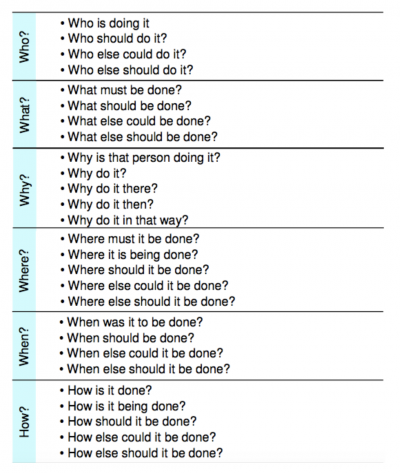
6W is a logical approach used in Lean Six Sigma projects in order to guarantee that a problem or topic under discussion is analyzed from all the relevant perspectives. In this article, we will present what the 6Ws are, explore variations on the concept, and describe its benefits and best practices.
Overview: What is 6W?
The six Ws are:
- What
- Why
- Where
- Who
- When
- Which
Different authors will present them in a variety of sequences. The idea of asking six questions to analyze a project or problem came from a poem by the famous poet Rudyard Kipling. You will note that the original poem really mentioned 5Ws and a H. This is the more common approach rather than the 6Ws.
The stanza associated with the technique is:
“I keep six honest serving-men
(They taught me all I knew)
Their names are What and Why and When
And How and Where and Who.”
Since the 5W1H approach is the most widely used, we will describe and explain how that process works. As mentioned before, you can use a variety of sequences for the 5W1H depending on the situation.
Here is one of them:

Image source: ingegneriaagileesnella.
In the context of problem-solving, you might use this sequence of questions:
- Who noticed the problem?
- What is the problem?
- When did the problem start?
- Where is the problem?
- Why did the problem occur?
- How should you fix the problem?
In the context of project management, you might try this approach:
- Who should do the required tasks?
- What, specifically, should they do?
- When should the tasks be complete?
- Where should the tasks be completed?
- Why is this task required?
- How should the task be completed?
3 benefits of 6W
Whether you choose to use the 6W or the 5W1H approach, you will benefit from the structured questioning.
Simple, complete and quick
You don’t have to use any complex statistics or advanced methodologies to use this technique. Asking the questions and analyzing the answers will provide you a quick insight into how you should proceed to solve your problem.
Flexible
You can use the 5W1H approach to solve business problems as well as personal problems. It can be applied across an organization, in any function or department.
Structured thinking
The sequence of questions is logical and lets you break the problem down into manageable pieces. It also allows you to attack the problem from different perspectives.
Why is 6W important to understand?
Understanding the use of the multiple questions of either 6W or 5W1H will result in you delving deeper and more completely into your problem.
Breaks the problem down
All problems have multiple dimensions. You will better understand your problem and how to fix it if you break it down into separate focuses: What is happening, where it is happening, why it is happening and how you can go about resolving the problem.
Provides a stepwise approach
The sequence of the 6W or 5W1H is not random. It’s a logical build. If you understand that, the questions will build upon themselves — so the How will make sense and be obvious to you.
Improves communication
You will often want to use the 6W or 5W1H approach with a team of people. Since the questions and answers will be a shared experience, communication among the team will be enhanced and will lead to a more robust and better solution.
An industry example of 6W
A glass company was experiencing an increase in breakage of their glass panels. While there are many problem-solving approaches, such as the 5 Whys and fishbone diagram, they chose to start with a version of the 5W1H approach.
Here’s what they did:
- What is happening? Increased glass breakage.
- Where is it happening? The line 4 laminating machine.
- When did the problem start? QC noticed a significant increase two weeks ago.
- Why is the problem happening? Upon investigation, it was concluded that the glass sheets had an increased occurrence of air bubbles, which weakened the glass when put under pressure.
- Who should deal with this? QC, line operators, engineering, and procurement.
- How will this be fixed? Incoming inspection will double its inspection rate, and procurement and engineering will visit the supplier to see if they can help them solve the problem of increased air bubbles in the glass.
3 best practices when thinking about 6W
The process of asking the questions is easy. Your challenge will be to stay on task and drill down on the questions to uncover the solution.
1. Fix the root cause not treat the symptom
You should strive to come up with a long-term solution rather than a temporary band aid solution.
2. Objective solution
Rely on as much data as you can. The problem and eventual solution should be expressed quantitatively rather than subjectively.
3. Explore multiple solutions
Don’t jump at the first set of conclusions. Explore multiple improvement opportunities, and then pick the best — or synthesize among a number of your possible solutions.
Frequently Asked Questions (FAQ) about 6W
What is 6W used for?
It’s a logical series of questions used to guarantee that a problem or topic under discussion is looked at from a number of different perspectives.
What are the 6Ws?
While the sequence may vary, the 6Ws are what, why, where, who, when, and which.
What is the difference between 6W and 5W1H?
The “which” in 6W is substituted for “how” in the 5W1H approach.
Let’s summarize 6W
6W is a set of logical sequential questions that you ask when analyzing a problem. A similar approach, 5W1H, asks these serial questions culminating in the question, “How can you solve the problem?”